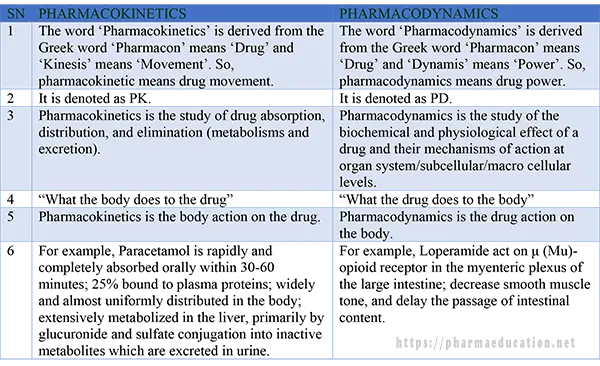Difference between pharmacokinetics and pharmacodynamics is a common question in pharmacology. Pharmacokinetics and pharmacodynamics are two important areas of pharmacology. Simply, the difference between Pharmacokinetics and Pharmacodynamics is discussed below:
Pharmacokinetics vs Pharmacodynamics
1. Etymology of Pharmacokinetics and Pharmacodynamics
The word ‘Pharmacokinetics’ is derived from the Greek word ‘Pharmacon’ means ‘Drug’ and ‘Kinesis’ means ‘Movement’. So, pharmacokinetic means drug movement. On the other hand, the word ‘Pharmacodynamics’ is derived from the Greek word ‘Pharmacon’ means ‘Drug’ and ‘Dynamis’ means ‘Power’. So, pharmacodynamics means drug power.
2. Pharmacokinetics is denoted as PK. While Pharmacodynamics is denoted as PD.
3. Definition of Pharmacokinetics and Pharmacodynamics
Pharmacokinetics is the study of drug absorption, distribution, and elimination (metabolisms and excretion). So, pharmacokinetic describes:
- Absorption: How a drug is absorbed from the stomach and intestine into the body (if it is an oral drug),
- Distribution: How the drug becomes distributed through the body fluids and tissues,
- Metabolisms: How and what extent a drug is metabolized by the liver and other organs,
- Excretion: How the drug is excreted from the body (usually in the urine, feces, skin, and other routes).
While Pharmacodynamics is the study of the biochemical and physiological effect of a drug and their mechanisms of action at the organ system/sub-cellular/macro cellular levels.
4. Pharmacokinetics is “what the body does to the drug”. On the other hand, Pharmacodynamics is “what the drug does to the body”.
5. Simply, Pharmacokinetics is the body’s action on the drug or alteration of a drug by the body. While Pharmacodynamics is the drug action on the body.
6. Example of Pharmacokinetics and Pharmacodynamics
Example of pharmacokinetics: Paracetamol is rapidly and completely absorbed orally within 30-60 minutes; 25% bound to plasma proteins; widely and almost uniformly distributed in the body; extensively metabolized in the liver, primarily by glucuronide and sulfate conjugation into inactive metabolites which are excreted in urine.
While the example of pharmacodynamics: Loperamide act on μ (Mu)-opioid receptor in the myenteric plexus of the large intestine; decrease smooth muscle tone, and delay the passage of intestinal content.
Summary of the difference between Pharmacokinetics and Pharmacodynamics
| SR. No. | PHARMACOKINETICS | PHARMACODYNAMICS |
| 1 | The word ‘Pharmacokinetics’ is derived from the Greek word ‘Pharmacon’ means ‘Drug’ and ‘Kinesis’ means ‘Movement’. So, pharmacokinetic means drug movement. | The word ‘Pharmacodynamics’ is derived from the Greek word ‘Pharmacon’ means ‘Drug’ and ‘Dynamis’ means ‘Power’. So, pharmacodynamics means drug power. |
| 2 | It is denoted as PK. | It is denoted as PD. |
| 3 | Pharmacokinetics is the study of drug absorption, distribution, and elimination (metabolisms and excretion). | Pharmacodynamics is the study of the biochemical and physiological effect of a drug and their mechanisms of action at organ system/subcellular/macro cellular levels. |
| 4 | “What the body does to the drug” | “What the drug does to the body” |
| 5 | Pharmacokinetics is the body action on the drug. | Pharmacodynamics is the drug action on the body. |
| 6 | For example, Paracetamol is rapidly and completely absorbed orally within 30-60 minutes; 25% bound to plasma proteins; widely and almost uniformly distributed in the body; extensively metabolized in the liver, primarily by glucuronide and sulfate conjugation into inactive metabolites which are excreted in urine. | For example, Loperamide act on μ (Mu)-opioid receptor in the myenteric plexus of the large intestine; decrease smooth muscle tone, and delay the passage of intestinal content. |
Image of the difference between Pharmacokinetics and Pharmacodynamics

Please leave a Comment about the difference between pharmacokinetics and pharmacodynamics.
Also, you may read: